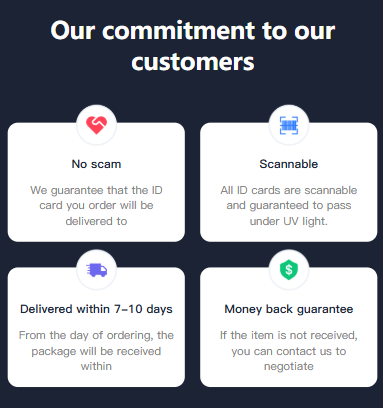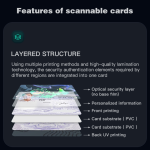In the digital – centric landscape of 2025, fake ID scams have become more sophisticated and prevalent. Scammers are constantly devising new ways to trick individuals into falling victim to their schemes. Protecting yourself from these scams is not only crucial for your personal security but also for safeguarding your financial well – being. Here are some key strategies to help you stay safe.
Understand the Types of Fake ID Scams
The first step in protection is awareness. One common type of fake ID scam in 2025 involves online vendors claiming to sell legitimate identification documents at a fraction of the cost. These scammers often use flashy websites with promises of fast delivery and high – quality fake IDs that can pass any inspection. However, once you send them money, they either disappear or send you a sub – par product that is easily detectable as fake.
Another type is the identity theft – related fake ID scam. Scammers may steal your personal information through phishing emails, data breaches, or social engineering techniques. They then use this information to create fake IDs in your name, which can be used for various illegal activities such as fraud, credit card misuse, or even criminal acts. In some cases, they may also sell your information on the dark web to other criminals who will create and use fake IDs.

Be Wary of Online Purchases
If you come across an online site offering to sell IDs, be extremely cautious. Legitimate identification documents are issued by authorized government agencies, and it is illegal to purchase them from any other source. Check the website’s URL carefully. Scam websites often have misspelled domain names or use sub – domains that mimic legitimate ones. For example, instead of “governmentid.com”, it might be “govermentid.com” or “government – id.net”.
Look for signs of a legitimate business, such as a physical address, phone number, and customer support. If a website only offers an email address or a chat function, it’s a red flag. Additionally, beware of websites that demand payment through untraceable methods like cryptocurrency or prepaid gift cards. Legitimate businesses will usually accept more traditional forms of payment that offer some level of consumer protection.
Protect Your Personal Information
Your personal information is the key ingredient for scammers to create fake IDs in your name. Keep your sensitive data, such as your Social Security number, date of birth, and driver’s license number, as secure as possible. Only share this information when absolutely necessary and with trusted entities. When filling out forms online, make sure the website is secure. Look for the “https” prefix in the URL and the padlock icon in the browser address bar.

Regularly monitor your financial accounts and credit reports. Unauthorized activity on your accounts or sudden changes in your credit score could be signs that someone has used your information to create a fake ID and engage in fraudulent activities. You are entitled to a free credit report from each of the three major credit bureaus (Equifax, Experian, and TransUnion) once a year. Review these reports carefully for any errors or suspicious accounts.
Educate Yourself on ID Verification
As an individual, it’s beneficial to have some knowledge of how real identification documents are verified. For example, most driver’s licenses and passports in 2025 have advanced security features such as holograms, microprinting, and embedded chips. Familiarize yourself with these features so that you can spot a fake ID if you are ever presented with one, whether in a professional or personal context. If you work in an industry where ID verification is part of your job, stay updated on the latest security features and verification techniques.
When in doubt about the authenticity of an ID, don’t be afraid to ask for additional forms of identification or contact the relevant issuing authority. For example, if you are a bouncer at a club and suspect a patron’s ID is fake, you can ask for a secondary form of ID like a credit card with a matching photo or call the local Department of Motor Vehicles to verify the license number.
Stay Informed about the Latest Scams
The world of fake ID scams is constantly evolving. Scammers are always coming up with new tactics and techniques. Subscribe to security newsletters, follow official government security websites, and stay informed about the latest trends in fraud prevention. Social media can also be a valuable source of information, but make sure to verify the credibility of the sources you follow.
Join online communities or forums where people share their experiences with fake ID scams and discuss ways to protect themselves. By staying informed, you can be better prepared to recognize and avoid potential scams before they affect you.
Expand on Common Problems and Solutions
Problem 1: Phishing Emails Claiming to Be from ID – Issuing Agencies
Scammers often send phishing emails that appear to be from legitimate ID – issuing agencies like the DMV or the passport office. These emails may ask you to click on a link to update your personal information or verify your identity. The links usually lead to fake websites designed to steal your information.
Solution: Never click on links in unsolicited emails. If you receive an email claiming to be from an ID – issuing agency, go directly to the official website of that agency by typing the URL into your browser. Contact the agency’s official customer service number (found on their official website) to verify the authenticity of the email. Legitimate agencies will not ask for sensitive information like your Social Security number or password via email.
Problem 2: Fake ID Vendors on Social Media
Social media platforms have become breeding grounds for fake ID vendors. They often use encrypted messaging apps to communicate with potential customers and avoid detection. They may post enticing advertisements with fake testimonials and promises of high – quality fake IDs.
Solution: Report any accounts or posts that appear to be promoting the sale of fake IDs on social media. Social media platforms have policies against such illegal activities. Do not engage with these vendors, even out of curiosity. Remember that purchasing a fake ID is a crime, and you could face serious legal consequences.
Problem 3: Data Breaches Leading to Fake ID Creation
With the increasing number of data breaches in 2025, personal information is being exposed at an alarming rate. Scammers can use the information from these breaches to create fake IDs in the names of the victims.
Solution: Regularly change your passwords on all important accounts, especially those related to your identity and finances. Use strong, unique passwords that include a combination of letters, numbers, and special characters. Consider using a password manager to keep track of your passwords. Enable two – factor authentication whenever possible. This adds an extra layer of security by requiring a second form of verification, such as a code sent to your phone, in addition to your password.
Problem 4: Difficulty in Spotting Subtle Differences in Fake IDs
Some fake IDs in 2025 are becoming more sophisticated, making it difficult to spot the differences from real ones at first glance. The security features may be replicated poorly, but it can still be challenging to tell them apart without close inspection.
Solution: Invest in ID verification tools if you are in a profession that requires frequent ID checks, such as security or law enforcement. These tools can help you detect fake IDs more accurately. Additionally, take training courses on ID verification. Many organizations offer courses that teach you how to identify the latest security features and spot common signs of a fake ID, such as inconsistent font styles, misaligned images, or incorrect hologram placement.
Problem 5: Falling Victim to Social Engineering Tactics for ID Information
Scammers are masters of social engineering. They may pose as a trusted authority figure, such as a bank employee or a government official, and use psychological tactics to trick you into giving up your ID – related information.
Solution: Be skeptical of any unsolicited requests for personal information, especially if the person is pressuring you to act quickly. Ask for the person’s name, employee ID number, and contact information. Then, independently verify their identity by calling the official phone number of the organization they claim to represent. Do not be afraid to say no and hang up if you feel uncomfortable or suspicious.
Fake ID Pricing
unit price: $109
| Order Quantity | Price Per Card |
|---|---|
| 2-3 | $89 |
| 4-9 | $69 |
| 10+ | $66 |


